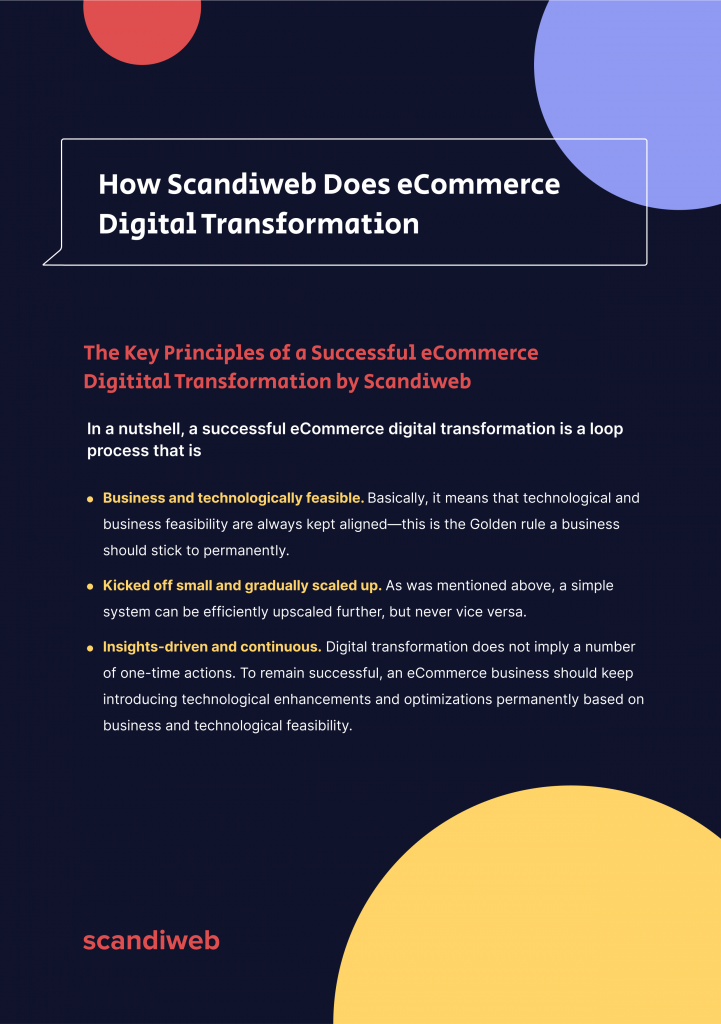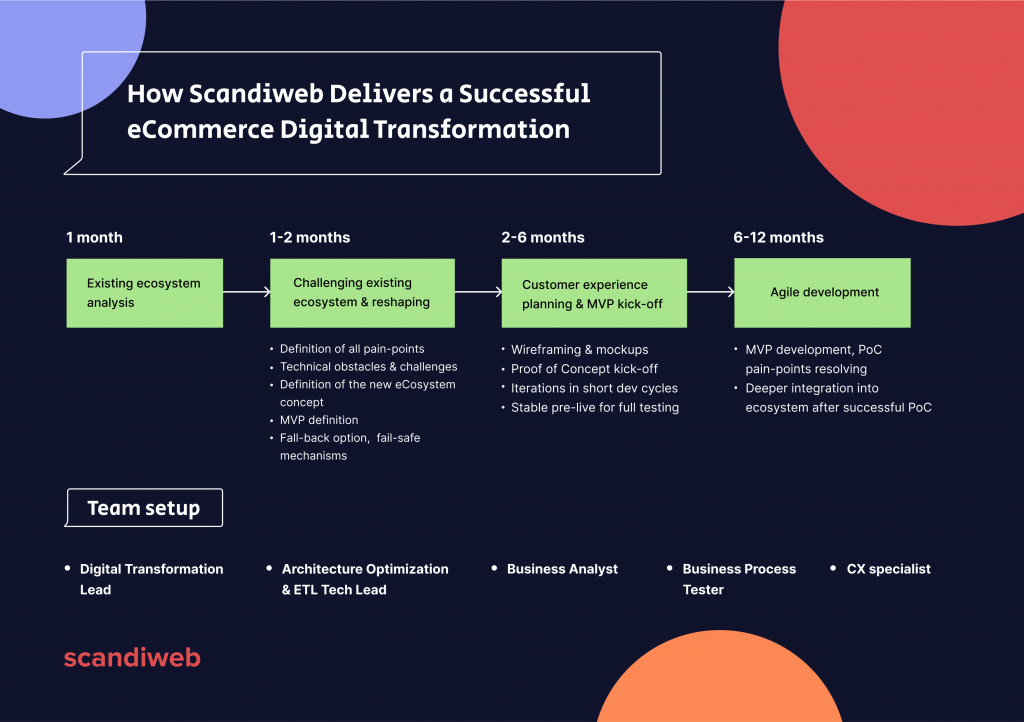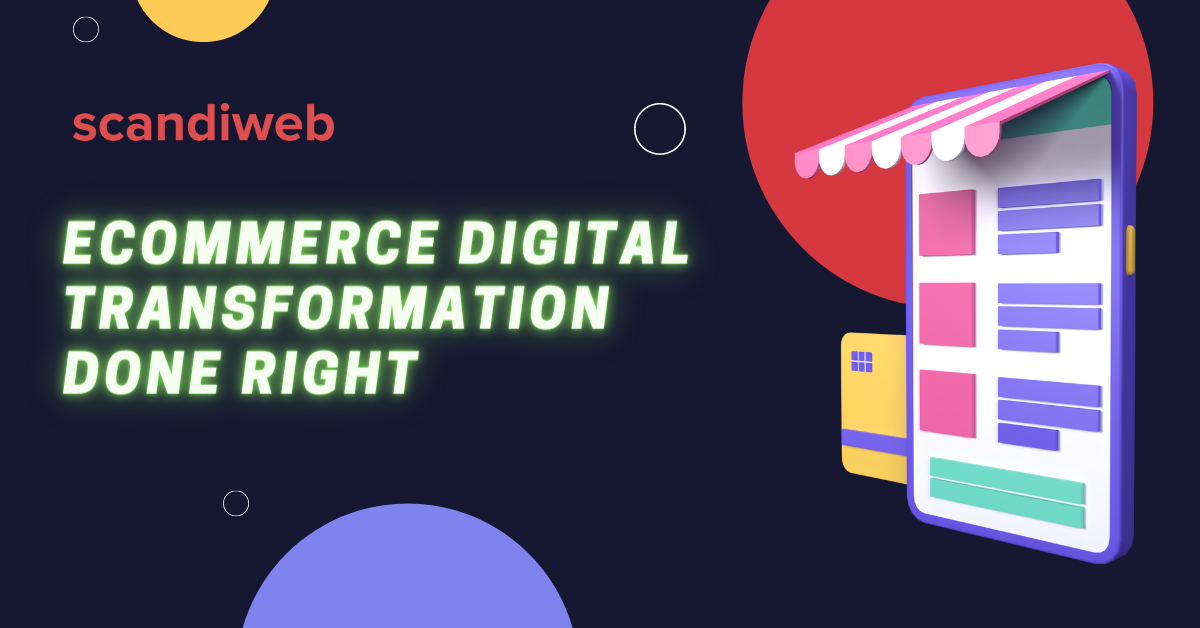What is eCommerce digital transformation and how to do it right
eCommerce digital transformation has been the talk of the town among eCommerce businesses and experts for years. Simply put, eCommerce digital transformation is a process of utilizing digital technologies to develop new—or improve current—business processes in order to satisfy changing business and market requirements as well as uplevel customer experience.
To a great extent, much of the word fluff and high-flown rhetoric around eCommerce digital transformation have brought up more questions than answers as well as misconceptions about how things should actually be done—in practice, roughly 30% of digital transformation attempts are successful. So why do 7 out of 10 companies fail on their way to an efficient, digitized business model?
We’ve gone a long way from the proto-eCommerce times when the West Berlin blockade of the late 1940s induced the first-ever remote ordering of goods via a customer-to-customer switched network—telex. In theory, everything that was to come within the remote/digitized ordering of goods, including the emergence of the term eCommerce itself in the 1970s, was supposed to be predictable and relatively easy to implement.
But in reality, each decade brought up dozens of theories and showed numerous attempts at how companies are supposed to digitize themselves and keep generating revenue with new tech solutions. As we see, to this day, only one-third of them are successful at it.
So did the experts and entrepreneurs actually lose track of where the digitalization of business was going? Did they fail at coming up with a sustainable and commonly applicable digital transformation methodology that would work despite the industry and time?
The answer is yes and no. The thing is that technological progress has been way more intense in the past 60 years compared to all the previous centuries combined, especially after semiconductors were discovered.
There’s also ever-evolving customer behavior, which, in turn, is influenced by technological advancement. Many brands just don’t get how fast-paced the context they are operating in is, both technologically and economically.
What is efficient today, can quickly become inefficient and rudimentary tomorrow—many businesses don’t get that. In many ways, this reluctance to dispose of outdated tech solutions, enhance the ecosystem, as well as unwillingness to boost eCommerce sales channels are the main reasons why companies fall behind their competitors. This fear of change is also ignited by too much information a company gets bombarded with both from outside and within, e.g.
- How many steps are there to a successful digital transformation?
- What should be digitized first—technology, company structure, and/or culture?
- Should this or that legacy system be kept or completely discounted, etc?
When stepping on the road of digital transformation, asking too many questions right off the bat is a bad idea. A complex system that actually works is invariably found to have evolved from a simple system that worked.
The opposite is also true: a complex system designed from scratch never works and cannot be made to work—and that’s exactly what happens when you start asking too many questions already at the very start.
In a nutshell, a successful eCommerce digital transformation is a loop process that is
- Business and technologically feasible. Basically, it means that technological and business feasibility are always kept aligned—this is the Golden rule a business should stick to permanently.
- Kicked off small and gradually scaled up. As was mentioned above, a simple system can be efficiently upscaled further, but never vice versa.
- Insights-driven and continuous. Digital transformation does not imply a number of one-time actions. To remain successful, an eCommerce business should keep introducing technological enhancements and optimizations permanently based on business and technological feasibility.

If a company accepts the idea of going through a digital transformation based on this tree-pilar mindset, all the rest will get in line, e.g. company culture, IT and management skills of the employees, etc.
With this approach at its core, scandiweb has developed and successfully implemented its own 7-step digital transformation strategy. Here is how it works.
How scandiweb digital transformation methodology works

Step 1. Getting to know the eCommerce ecosystem from within
At this step, we figure out what are the actual tech blockers to higher business efficiency—this important in terms of aligning tech and business feasibility.
This step includes
- The analysis of the current system architecture
- Interviews with stakeholders
- Analysis of the ecosystem documentation: ecosystem overview, data models, component dependencies.
Step 2. Challenge the existing ecosystem setup
After we defined the pain points and blockers (What is blocking the process?), we proceed to identify the nature behind these stoppers (How is it blocking the process?).
This stage includes
- Interviews with selected stakeholders
- Best practices sharing
- Documentation of edge-cases of the existing setup
- Listing hypothesis of improvements.
Step 3. Target ecosystem architecture setup & platform selection
At this step, we basically build up a blueprint of the systems a business is using for the construction of all their relationships within and outside the company.
This stage includes
- Tech solutions comparison
- Definition of optimized solution architecture.
Step 4. MVP development with fail-safe mechanisms
When it comes to practice, we start small. We develop a proof of concept and test it, without any impact on ongoing operations—the business goes as usual while we’re running the tests and analyzing the success rate of the MVP. Fallback logic is at the core of the new target ecosystem definition, ensuring end-to-end testing in a pre-live environment and safe experimentation at the live stage.
This includes
- MVP definition
- Fallback mechanism definition
- Iterations plan
Step 5. Customer experience prioritization
The user interface is crucial for the adoption of the new system. At this step, we develop the full end-user as well as administrator journey.
This stage includes
- User journey mapping
- Mockups & wireframing
- Admin user interface journey planning
- Development-ready designs
Step 6. Adaptation across the company
At this step, we help the employees, especially the managers, to prepare for the upcoming changes and accept them across the company.
This stage includes
- On-site workshops & education sessions
- PoC communication across all stakeholders
Step 7. Agile iterations to reach business goals
Agile transformation is the core of the development process. At this step, a series of iterations are implemented to reach the initially planned business goals.
This stage includes
- Development kick-off
- Short development cycles with demos
- Adoption of changing requirements based on real-life results
Final thoughts
eCommerce digital transformation can be done right if approached with the right mindset, which implies a business’s willingness to change in the first place. At scandiweb, we know that from the practice of multiple successful digital transformation projects done for our clients.
Related Articles
scandiweb Launches Metaverse on Roblox for Sportland
Building a B2B eCommerce Ecosystem for an IT Supplier
Implementing Attraqt’s AI-Powered Recommendation Engine on Magento 2 for The MET Store
Planning a digital transformation for your eCommerce business? We’ll gladly get on it! Connect with us via [email protected] or just hit the orange chat bubble you see in the bottom right corner.

Share on: